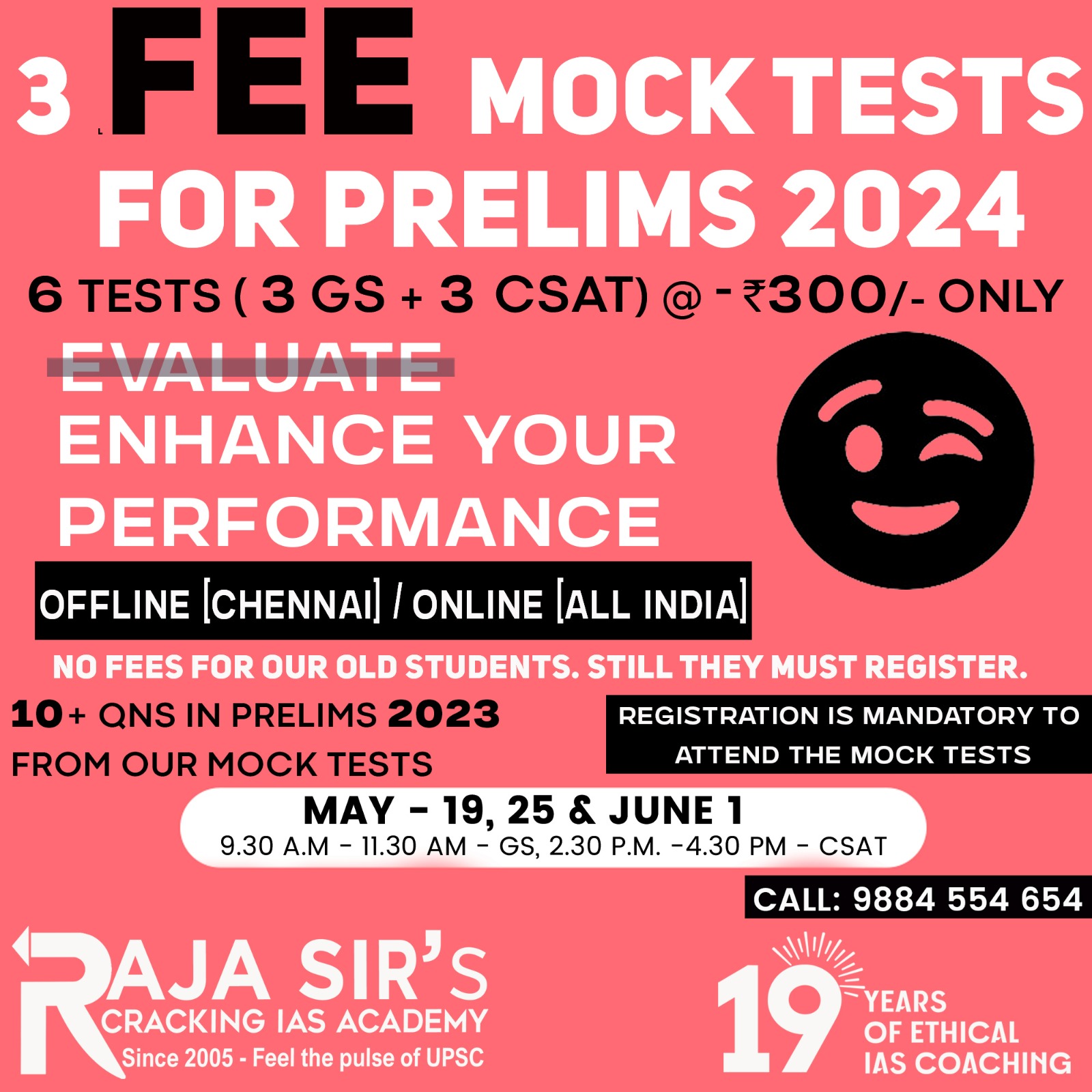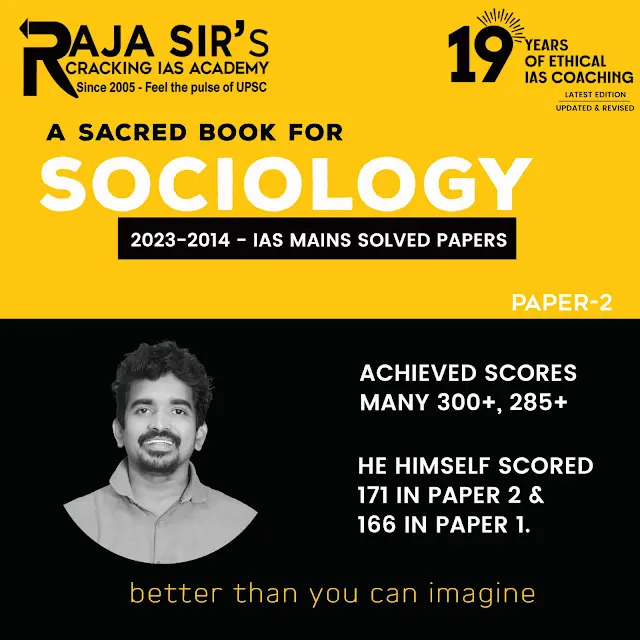- Home
- Prelims
- Mains
- Current Affairs
- Study Materials
- Test Series
Hit List Questions 3-PPP 100 PRELIMS 2024 -21
|
1. |
105th Amendment to Constitution is related to (a) Reservation in private educational institutions (b) States’ right to maintain their own OBC lists (c) Reservation in local bodies (d) States’ right to decline EWS Quota
|
||||||
|
2. |
1. Lord Mahavir was born Prince of the Ikshvaku Dynasty. 2. Parasparopagraho Jivanam is the motto of Jainism. 3. Ṇamokara mantra is the first prayer recited by the Jains while meditating. 4. Mahavira''s teachings were compiled by Indrabhuti Gautama. Which of the statements given above is/are correct w.r.t. Jainism? (a) 1, 2 and 3 only (b) 2 and 3 only (c) 1, 3 and 4 only (d) 1, 2, 3 and 4
|
||||||
|
3. |
Consider the following pairs with reference to the Ramsar sites and their locations:
How many of the pair(s) given above is/are correctly matched? (a) Only one pair (b) Only two pairs (c) All three pairs (d) None of the pair is correctly matched
|
||||||
|
4. |
In which of the following cases, the Supreme Court held that the doctrine of basic structure would apply to constitutional amendments after April 24, 1973? (a) Minerva Mill Case (b) Waman Rao Case (c) S.R. Bommai Case (d) Keshavanand Bharati case
|
||||||
|
5. |
Consider the following statements w.r.t. Application Supported by Blocked Amount system (ASBA): 1. It is developed by RBI. 2. Subscribing to issues via ASBA is a mandatory option since 2016. Which of the statements given above is/are correct? (a) 1 only (b) 2 only (c) Both 1 and 2 (d) Neither 1 nor 2
|
||||||
|
6. |
Consider the following statements regarding the Carbon Border Adjustment Mechanism (CBAM): 1. It is a duty on imports based on the amount of carbon emissions resulting from the production of the product. 2. It was proposed by UNEP. Which of the statements given above is/are correct? (a) 1 only (b) 2 only (c) Both 1 and 2 (d) Neither 1 nor 2
|
||||||
|
7. |
Judicial Review in the Indian Constitution is based on (a) Procedure established by law (b) Due process of Law (c) Rule of Law (d) Precedents and Conventions
|
||||||
|
8. |
Logistic Performance Index (LPI) is released by (a) World Bank (b) World Trade Organisation (c) World Economic Forum (d) United Nations Conference on Trade and Development
|
||||||
|
9. |
1. The McMahon Line passes through two Indian states. 2. It extends for about 550 miles from Bhutan in the west to the border of Myanmar in the east. Which of the above statements is/are correct w.r.t. McMohan Line?. (a) 1 only (b) 2 only (c) Both 1 and 2 (d) Neither 1 nor 2
|
||||||
|
10. |
Consider the following statements w.r.t. India’s Generic medicines: 1. Free drug initiative is implemented under National Health Mission. 2. A generic drug can only be marketed after the brand name drug''s patent has expired. 3. Data Exclusivity does not affect generic availability. Which of the above is/are correct? (a) 2 and 3 only (b) 1 and 2 only (c) 1, 2 and 3 only (d) 3 only
|
||||||
|
11. |
1. For every point on Earth between the Tropic of Cancer and the Tropic of Capricorn, there are two Zero Shadow Days a year. 2. Sun, in its highest point of the day, will move from 23.5 degrees south of the celestial equator to 23.5 degrees north of the equator, and back again, in a year. Which of the statements given above is/are correct? (a) 1 only (b) 2 only (c) Both 1 and 2 (d) Neither 1 nor 2
|
||||||
|
12. |
Sarla Mudgal judgment (1995) and in the Paulo Coutinho vs Maria Luiza Valentina Pereira case (2019) are connected with (a) Uniform Civil Code (b) Sabarimala temple entry (c) Political funding (d) LGBT Rights
|
||||||
|
13. |
1. WAIS Divide is an ice core. 2. They contain Hydrogen and Oxygen Isotopes. 3. Layers in ice cores correspond to years and seasons, with the oldest ice at the top and the youngest ice at the bottom of the core. How many of the statements given above is/are correct w.r.t. “Ice Cores”? (a) Only 1 statement is true. (b) Only 2 statements are true. (c) All the three statements are true. (d) None of the statement is true.
|
||||||
|
14. |
The 31st member of NATO is (a) Finalnd (b) Sweden (c) Georgia (d) Ukraine
|
||||||
|
15. |
1. For making Constitutional amendment to the Directive Principles of State Policies, special majority of both the houses of the Parliament is required. 2. Four Directive Principles were added by 42nd amendment. 3. Mahatma Gandhi National Rural Employment Guarantee Act (MGNREGA) get their authority from Article 39(a). Which of the statements given above is/are correct?. (a) Only one statement is true. (b) Only two statements are true. (c) All the statements are true. (d) All the statements are false.
|
||||||
|
16. |
The PM SVANidhi scheme is targeted for (a) Women in STEM research. (b) Upskilling of Gig workers. (c) Street vendors who have been affected due to the Covid-19 crisis. (d) Social security scheme for the destitute widows.
|
||||||
|
17. |
Where is “Rajamalai National Park”?. (a) Tamilnadu (b) Kerala (c) Karnataka (d) Andhra Pradesh
|
||||||
|
18. |
The secession of a state from the Indian Union has been barred by the (a)Constitution (Sixteenth Amendment) Act, 1963 (b)Constitution(Twenty-Second Amendment) Act, 1969 (c) Constitution (Twenty-Ninth Amendment) Act,1972 (d) Constitution (Thirty-Fifth Amendment) Act, 1974
|
||||||
|
19. |
“Kirit Parikh panel” is related to (a) Urea subsidy (b) PLI Scheme for Semiconductor (c) Conserving western Ghats (d) Pricing for gas
|
||||||
|
20. |
Which of the following is a major contributor to India''s import basket? (a) Electronics (b) Textile (c) Energy-related products (d) Gold
|
||||||
|
21. |
The sequence in which the given terms are mentioned in the preamble to the Constitution of India is (a) Sovereign, Socialist, Secular, Democratic, Republic (b) Socialist, Secular, Sovereign, Democratic, Republic (c) Secular, Sovereign, Democratic, Socialist, Republic (d) Sovereign, Democratic, Secular, Socialist, Republic
|
||||||
|
22. |
The European Parliament, the legislative body of the 27-country block European Union, has approved the world’s first set of comprehensive rules to bring largely unregulated cryptocurrency markets under the ambit of regulation by government authorities. The regulation called the Markets in Crypto Assets (MiCA), will come into force after formal approval by member states. MiCA regulation will be applicable to 1. Stablecoins 2. Non-Fungible tokens 3. Digital assets that would qualify as transferable securities. Select the incorrect statement(s): (a) 1 only (b) 1 and 2 only (c) 2 and 3 only (d) 3 only
|
||||||
|
23. |
Consider the following statements w.r.t. OPEC: 1. It has 13 member countries. 2. It has two member countries from South America. Which of the above statements is/are correct?. (a) 1 only (b) 2 only (c) Both 1 and 2 (d) Neither 1 nor 2
|
||||||
|
24. |
Consider the following statements: 1. Out of the five species of Rhino, only the Great One-Horned Rhino is found in India. 2. The Great One-Horned Rhino is listed as Critically Endangered in IUCN Red List. 3. The five rhino range nations include India, Bhutan, Nepal, Indonesia and Afghanistan. How many of the statements given above is/are correct? (a) Only 1 statement is true. (b) Only 2 statements are true. (c) All the three statements are true. (d) None of the statement is true.
|
||||||
|
25. |
Namsai Declaration seen in news was signed between (a) Assam and Manipur (b) Kerala and Karnataka (c) Maharashtra and Gujarat (d) Assam and Arunachal Pradesh
|
KEYS & EXPLANATIONS
|
1. |
B |
|||||||||||||||||||
|
2. |
Vardhamana Mahavira was the 24th Tirthankara of the Jain tradition. He married Yasoda and gave birth to a daughter. At the age of thirty he became an ascetic and wandered for twelve years. In the 13th year of his penance, he attained the highest spiritual knowledge called Kevala Gnana. After attaining Kevala Jnana, Mahavira taught that observance of the vows of ahimsa (nonviolence), satya (truth), asteya (non-stealing), brahmacharya (chastity), and aparigraha (nonattachment) is necessary for spiritual liberation. He taught the principles of Anekantavada (many-sided reality): syadvada and nayavada. Mahavira''s teachings were compiled by Indrabhuti Gautama (his chief disciple) as the Jain Agamas. |
D |
||||||||||||||||||
|
3. |
The Ramsar Convention on Wetlands defines wetlands as “areas of marsh, fen, peat land or water, whether natural or artificial, permanent or temporary, with water that is static or flowing, fresh, brackish or salt, including areas of marine water the depth of which at low tide does not exceed six meters”. The Ramsar Convention, which came into existence in 1971, is an intergovernmental treaty that provides the framework for national action and international cooperation for the conservation and wise use of wetlands and their resources. The five new wetlands added to the list are the Karikili Bird Sanctuary, Pallikaranai Marsh Reserve Forest, Pichavaram Mangrove, Sakhya Sagar, and Pala Wetland.
|
A |
||||||||||||||||||
|
4. |
Kesavananda Bharati Case (1973):
Basic Structure Doctrine
Evolution of the Basic Structure Doctrine:
Components
Benefits/Significance of the Basic Structure Doctrine:
Criticism of the Basic Structure Doctrine:
Conclusion:
|
B |
||||||||||||||||||
|
5. |
Application Supported by Blocked Amount (ASBA)
|
B |
||||||||||||||||||
|
6. |
A |
|||||||||||||||||||
|
7. |
|
A |
||||||||||||||||||
|
8. |
A |
|||||||||||||||||||
|
9. |
The McMahon Line passes through only one Indian state, which is Arunachal Pradesh.
https://indianexpress.com/article/explained/mcmahon-line-us-senate-8499398/ |
B |
||||||||||||||||||
|
10. |
B |
|||||||||||||||||||
|
11. |
C |
|||||||||||||||||||
|
12. |
A |
|||||||||||||||||||
|
13. |
B |
|||||||||||||||||||
|
14. |
|
A |
||||||||||||||||||
|
15. |
Four Directive Principles were added by 42nd amendment as follows: · To secure opportunities for healthy development of children (Article 39) · To promote equal justice and to provide free legal aid to the poor (Article 39 A) · To take steps to secure the participation of workers in the management of industries (Article 43 A) · To protect and improve the environment and to safeguard forests and wild life (Article 48 A). https://blog.ipleaders.in/directive-principles-of-state-policy-dpsp-under-the-indian-constitution/
|
C |
||||||||||||||||||
|
16. |
C |
|||||||||||||||||||
|
17. |
§ Eravikulam National Park situated along the summit of the Western Ghats in the high ranges of Idukki district of Kerala. § This is also the land of "Neelakurinji", a flower that blooms once in twelve years. The highest peak south of the Himalayas – the Anamudi is located here. § The park is also known as Rajamalai National Park. It was declared as a sanctuary with an objective of protecting the indigenous population of Nilgiri Tahr (most endangered mountain goat) when founded in the year 1975 and was then upgraded as the national park in 1978. |
|
||||||||||||||||||
|
18. |
|
A |
||||||||||||||||||
|
19. |
D |
|||||||||||||||||||
|
20. |
C |
|||||||||||||||||||
|
21. |
A |
|||||||||||||||||||
|
22. |
New rules
MiCA regulations
Exemptions
Significance of MiCA
Criticisms
Indian Government’s stand on Cryptocurrency & way ahead
|
A |
||||||||||||||||||
|
23. |
OPEC has 13 member countries (Algeria, Angola, Equatorial Guinea, Gabon, Iran, Iraq, Kuwait, Libya, Nigeria, the Republic of the Congo, Saudi Arabia, the United Arab Emirates and Venezuela): five in the Middle East (Western Asia), seven in Africa, and one in South America. |
A |
||||||||||||||||||
|
24. |
The five rhino range nations include India, Bhutan, Nepal, Indonesia and Malaysia. According to a recent study, published in the latest edition of People and Nature by the British Ecological Society, which used an interesting research approach—analysing artwork and photographs of the animal spanning more than five centuries. · It relied on a repository of images maintained by the Netherlands-based Rhino Research Centre (RRC). Major Findings: · Found evidence for declining horn length over time across species, perhaps related to selective pressure of hunting, and indicating a utility for image-based approaches in understanding societal perceptions of large vertebrates and trait evolution · The horns of rhinoceroses may have become smaller over time due to the impact of hunting. · The study found that the rate of decline in horn length was highest in the critically-endangered Sumatran rhino and lowest in the white rhino of Africa, which is the most commonly found species both in the wild and in captivity. · This observation follows patterns seen in other animals, such as tusk size in elephants and horn length in wild sheep, which have been driven down by directional selection due to trophy hunting. · During the age of European imperialism (between the 16th and 20th centuries), rhinos were commonly portrayed as hunting trophies, but since the mid-20th century, they have been increasingly portrayed in a conservation context, reflecting a change in emphasis from a more to less consumptive relationship between humans and rhinos. · The Indian rhino featured more in early artwork, but the number of images of other species, particularly white rhinos, has increased since the mid-19th century. Rhinos: · Rhinos have long been hunted for their horns, which are highly valued in some cultures. · The five surviving rhino species (Black and White African rhino, Asian rhino species – greater one horned, Sumatran and Javan rhinos) are still threatened by habitat loss and hunting. · IUCN Status: · Greater one horned Rhino: Vulnerable · Sumatran Rhino: Critically Endangered · Javan Rhino: Vulnerable · Black African Rhino: Critically Endangered · White African Rhino: Near Threatened Greater One-Horned Rhinoceros: · Also known as Indian rhino, it is the largest of the rhino species. · India is home to the largest number of Greater One-Horned Rhinoceros in the world. · At present, there are about 2,600 Indian rhinos in India, with more than 90% of the population concentrated in Assam’s Kaziranga National Park. Habitat: · The species is restricted to small habitats in Indo-Nepal terai and northern West Bengal and Assam. · In India, rhinos are mainly found in · Kaziranga NP, Pobitora WLS, Orang NP, Manas NP in Assam, · Jaldapara NP and Gorumara NP in West Bengal · Dudhwa TR in Uttar Pradesh. Threats: · Poaching for the horns · Habitat loss · Population density · Decreasing Genetic diversity Protection Status: · IUCN Red List: Vulnerable. · CITES: Appendix-I · Wildlife Protection Act, 1972: Schedule I. Conservation Efforts by India · The Ministry of Environment and Forests (MoEF) has launched a National Conservation Strategy for Indian One-Horned Rhino and the conservation initiatives for rhino has also enriched the grassland management which helps in reducing the negative impacts of climate change through carbon sequestration. · New Delhi Declaration on Asian Rhinos 2019: Signed by India, Bhutan, Nepal, Indonesia and Malaysia to conserve and protect the rhinos. · Project to create DNA profiles of all rhinos by the Ministry of Environment Forest and Climate Change (MoEFCC). · Indian Rhino Vision 2020: It is a unique programme where the government partnered international, national and local organisations for the conservation of the rhinos. Under it, Manas has received a total of 22 rhinos from other protectedareas. · The Indian and Nepalese governments have taken major steps toward Indian Rhinoceros conservation with the help of the World Wildlife Fund (WWF). |
A |
||||||||||||||||||
|
25. |
|
|









 Latest News
Latest News




 General Studies
General Studies